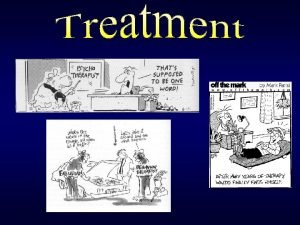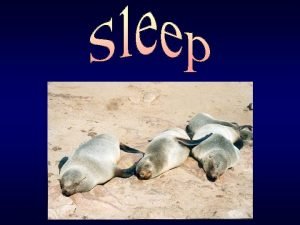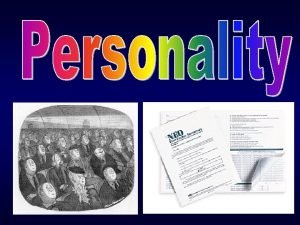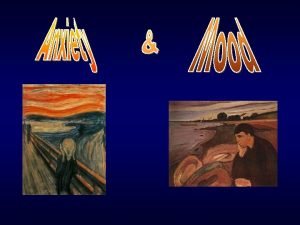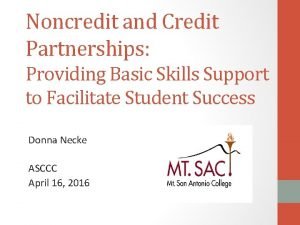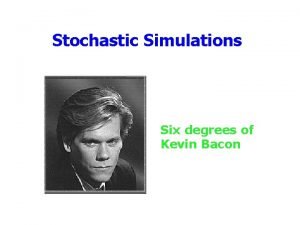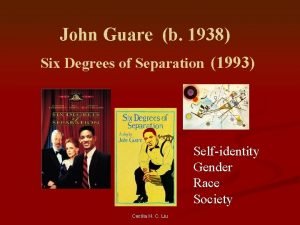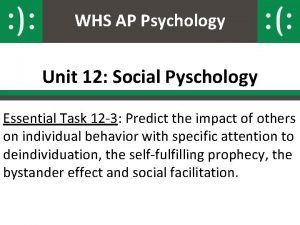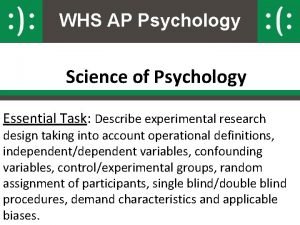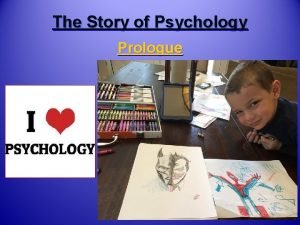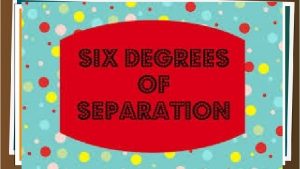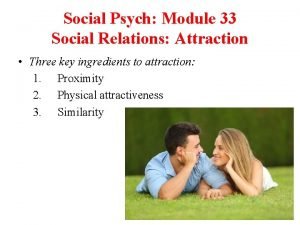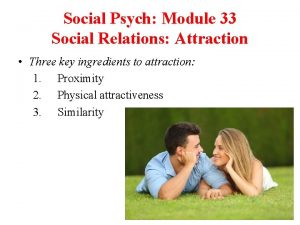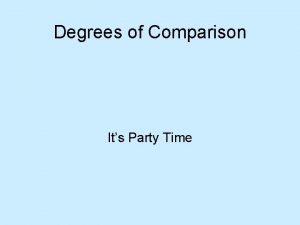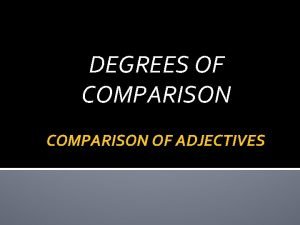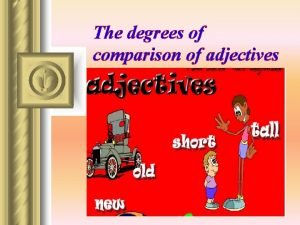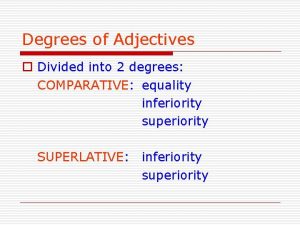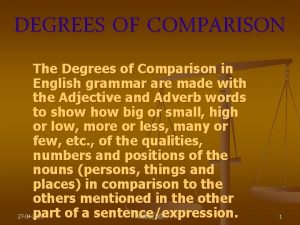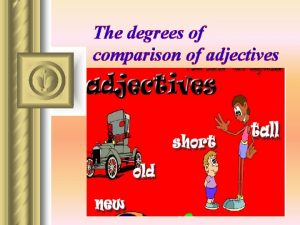Three Minute Review SOCIAL PSYCH DEGREES OF SEPARATION

























- Slides: 25


Three Minute Review SOCIAL PSYCH: DEGREES OF SEPARATION • Milgram’s experiment – 6 deg of separation • under- or over-estimation? • power law distribution – hubs • degrees of separation can vary – Hollywood: 3 – Internet: 19 • may have many applications – – understanding networks (e. g. , internet) public health terrorist networks brain connectivity

SIGMUND FREUD • Genius or misguided misogynist pervert? – huge impact on pop culture – Copernicus - Darwin - Freud – huge impact on some psychologists but largely debunked now – historical context important • hysterical women in Victorian Vienna – humans driven by unconscious motives, early development • psychoanalysis – “talking cure” • catharsis – hysteria • e. g. , glove anesthesia • Case study: Anna O. – can include hypnosis and free association – seduction theory vs. repressed desires?

• structures of the mind – unconscious, preconscious, conscious – id • “it” • fuelled by libido • pleasure principle – ego • self • reality principle – superego • conscience • ego ideal – could there be brain-based analogs of these “structures”? • hierarchical functions – newer areas (esp. frontal lobes) inhibit older areas (esp. limbic system)

Test Yourself • Elena and Robert have trouble getting along because she lives her life based on the pleasure principle and he lives his life based on his conscience. Freud would say Elena is driven by her _____ and Robert is driven by his _______. A. superego, ego B. id, ego C. id, superego D. ego, superego E. ego, id

What is Personality? • A person’s behavior is often consistent across situations

How can we explain personality types? • Non-psychological – Hippocrates four humors (5 th century B. C. ) – Astrology • Psychological – Trait theories • • • Sheldon’s body types Type A vs. B Sensation Seekers Cattell’s 16 Trait Model The Big 5 – Other theories… stay tuned till Thursday

Hippocrates Four Humors BLOOD “sanguine” • cheerful • confident • optimistic YELLOW BILE “choleric” • irritable • violent PHLEGM “phlegmatic” • sluggish • apathetic • dull BLACK BILE “melancholic” • depressed • gloomy • pessimistic • In the 5 th C. B. C. , Hippocrates theorized that the body contained four humors (fluids), each associated with a particular temperament

Astrology

Sheldon’s Body Types • William Sheldon (1942) suggested physique is related to temperament • still popular in media today • motivated Yale and Wellesley to take nude photos of 1000 s of students to test hypotheses

Sheldon’s Body Types ECTOMORPH • thin, long, fragile • brainy, artistic, introverted “Niles Crane” on Frasier MESOMORPH ENDOMORPH • muscular, rectangular, strong • fat, soft, round • physical, energetic, courageous • relaxed, sociable, warm • likes to eat, sedentary Arnold Schwartzenegger “Dan” on Roseanne

“Type A” Personality Type A • competitive – self-critical – driven – demanding of self and others • urgency – everything must be done NOW! – easily irritated by delays • anger/hostility – become easily angered even if they don’t express it overtly Appointment book of Type A person who died of a heart attack soon after this date Type B • low competitiveness, urgency, and hostility • “stop and smell the roses”

Type A ? 1. I often choose to spend time with my friends or family, even though I have something important to do. No 2. People who don't know what they want get on my nerves. Yes 3. I function best under stress or pressure. Yes 4. Talking about emotions is a sign of weakness and can be used by others to get at you. Yes 5. If everybody did their job properly, my life would be much easier. Yes

“Type A” Personality Type A’s: • respond more quickly and strongly to stress • seek more demanding situations • have greater reactivity to stress – when competing in a video game rigged so they always lost and taunted by their competitor, Type A’s showed greater “flight or fight” responses – cause and effect not clear • beta-blockers ( SNS responses) Type A behavior • more common in males than females • experience health risks – more respiratory problems, coronary heart disease (e. g. , 2 X rate of heart attacks) – they’re also more likely to drink, smoke, be obese and overwork but the health risks remain even when these are factored out

“Type C” Personality? • suggested in 1990 s • sociable, nice people who keep negative emotions “bottled up” • may be at increased risk for cancer and less likely to survive if they get it

Optimists live longer • • optimists have half as many illnesses optimists diagnosed with cancer live longer optimists have stronger immune systems optimism/pessimism test at age 25 predicts health after ~age 45

Sensation Seeking • "defined by the need for varied, novel, and complex sensations and experiences and the willingness to take physical and social risks for the sake of such experiences“ • most common in men aged 16 -19 – less common in women – declines with age

Sensation Seeking Tests Sample items: I would like to try parachute jumping. I sometimes do crazy things just to see the effect on others. I wish I didn’t have to waste so much of the day sleeping. What would you do if you won one million dollars? High SS: sports cars, big sailboats, one-night stands Low SS: luxury or comfort items High SS not simply party animals, often become entrepreneurs, entertainers, scientists, and adventurers.

Cattell’s Trait Theory Remember this guy? (Fluid vs. Crystallized Intelligence) Raymond Cattell 1905 -1998 • How can we decide what fundamental traits are? • dictionary identifies 18, 000 personality descriptors (Allport, 1937) • Cattell narrowed this down to 170 and used factor analysis to group them • Cattell derived 16 source traits

Factor Analysis CORRELATION How much do you like Dr. Pepper? r =. 70 How much do you like Coke Classic? CORRELATION MATRIX Coke Classic Dr. Pepper 7 -UP Ginger Ale Coke Classic --- . 70 . 20 . 33 Dr. Pepper --- . 16 . 18 7 -UP --- --- . 77 Ginger Ale --- ---

Factor Analysis of Personality • What would you conclude from the following patterns? CORRELATION MATRIX Sociable Talkative Worrying Impatient Sociable --- -. 03 -. 02 . 07 Sociable --- . 70 . 02 . -. 26 Talkative --- . 05 . 01 Talkative --- . 10 -. 03 Worrying --- --- -. 01 Worrying --- --- . 67 Impatient --- ---

Differences in Traits Both are equally intelligent Clergy members are more cheerful Researchers are more radical

Eysenck’s Three Factors Extroversion (vs. Introversion) • Do you like mixing with people? (+) • Do you like plenty of bustle and excitement around you? (+) • Are you rather lively? (+) Neuroticism (Stable vs. Unstable) • Do you often feel fed up? (+) • Do you often feel lonely? (+) • Does your mood often go up and down? (+) Psychoticism • Do good manners and cleanliness matter to you? (-) • Does it worry you if you know there are mistakes in your work? (-) • Do you like taking risks for fun? (+)

Eysenck is similar to Hippocrates

The BIG Five OPENNESS Openness Imaginative Independent Curious Broad interests CONSCIENTIOUSNESS Non-openness Unimaginative Conforming Incurious Narrow interests Conscientiousness Careful Reliable Persevering Ambitious EXTROVERSION Extroversion Sociable Fun-loving Talkative Spontaneous Undirectedness Careless Undependable Lax Aimless AGREEABLENESS Introversion Reserved Sober Quiet Self-controlled Agreeableness Courteous Selfless Trusting Cooperative Antagonism Rude Selfish Suspicious Uncooperative NEUROTICISM Neuroticism Worrying Vulnerable Self-pitying Impatient Stability Calm Hardy Self-satisfied Patient Mnemonic: O C E A N
 Degree of seperation
Degree of seperation What drives people
What drives people Three minute review
Three minute review Three minute review
Three minute review Three minute review
Three minute review Three minute review
Three minute review Three minute review
Three minute review Convert from degrees to radians 225 degrees
Convert from degrees to radians 225 degrees Whats a radian
Whats a radian Psych tech program mt sac
Psych tech program mt sac 7 degrees of kevin bacon
7 degrees of kevin bacon Guareb
Guareb 1 minute and a half
1 minute and a half Frustration aggression principle
Frustration aggression principle Social loafing ap psychology definition
Social loafing ap psychology definition Superordinate goals
Superordinate goals Comparison degree
Comparison degree Social media six degrees
Social media six degrees Social thinking social influence social relations
Social thinking social influence social relations Social thinking social influence social relations
Social thinking social influence social relations Independent variable
Independent variable Frankston ccu
Frankston ccu Io psych memes
Io psych memes Conformity definition ap psych
Conformity definition ap psych Ucf psychology neuroscience track
Ucf psychology neuroscience track Projection of feelings
Projection of feelings



